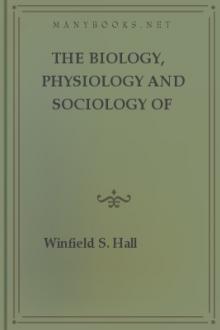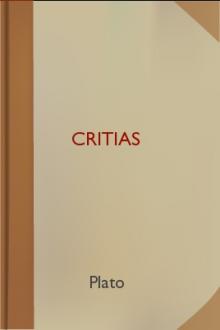Illusions, James Sully [speld decodable readers .TXT] 📗

- Author: James Sully
- Performer: -
Book online «Illusions, James Sully [speld decodable readers .TXT] 📗». Author James Sully
It follows from this that, though an error of the latter sort might conceivably have its origin in one of the former; though, for example, a man's illusory opinion of himself might be found to involve errors of introspection, yet the two kinds of illusion would be sufficiently unlike. The latter would be a simple presentative error, the former a compound representative error.
Finally, in order to complete this preliminary demarcation of our subject-matter, it is necessary to distinguish between an introspection (apparent or real) of a feeling or idea, and a process of inference based on this feeling. The term introspective knowledge must, it is plain, be confined to what is or appears to be in the mind at the moment of inspection.
By observing this distinction, we are in a position to mark off an illusion of introspection from a fallacy of introspection. The former differs from the latter in the absence of anything like a conscious process of inference. Thus, if we suppose that the derivation by Descartes of the fact of the existence of God from his possession of the idea to be erroneous, such a consciously performed act of reasoning would constitute a fallacy rather than an illusion of introspection.
We may, then, roughly define an illusion of introspection as an error involved in the apprehension of the contents of the mind at any moment. If we mistake the quality or degree of a feeling or the structure of a complex mass of feeling, or if we confuse what is actually present to the mind with some inference based on this, we may be said to fall into an illusion of introspection.
But here the question will certainly be raised: How can we conceive the mind erring as to the nature of its present contents; and what is to determine, if not my immediate act of introspection, what is present in my mind at any moment? Indeed, to raise the possibility of error in introspection seems to do away with the certainty of presentative knowledge.
If, however, the reader will recall what was said in an earlier chapter about the possibility of error in recognizing the quality of a sense-impression, he will be prepared for a similar possibility here. What we are accustomed to call a purely presentative cognition is, in truth, partly representative. A feeling as pure feeling is not known; it is only known when it is distinguished, as to quality or degree, and so classed or brought under some representation of a kind or description of feeling, as acute, painful, and so on. The accurate recognition of an impression of colour depends, as we have seen, on this process of classing being correctly performed. Similarly, the recognition of internal feelings implies the presence of the appropriate or corresponding class-representation. Accordingly, if it is possible for a wrong representation to get substituted for the right one, there seems to be an opening for error.
Any error that would thus arise can, of course, only be determined as such in relation to some other act of introspection of the same mind. In matters of internal perception other minds cannot directly assist us in correcting error as they can in the case of external perception, though, as we shall see by-and-by, they may do so indirectly. The standard of reality directly applicable to introspective cognition is plainly what the individual mind recognizes at its best moments, when the processes of attention and classifying are accurately performed, and the representation may be regarded with certainty as answering to the feeling. In other words, in the sphere of internal, as in that of external experience, the criterion of reality is the average and perfect, as distinguished from the particular variable and imperfect act of cognition.
We see, then, that error in the process of introspection is at least conceivable. And now let us examine this process a little further, in order to find out what probabilities of error attach to it.
To begin with, then, an act of introspection, to be complete, clearly involves the apprehension of an internal feeling or idea as something mental and marked off from the region of external experience. This distinct recognition of internal states of mind as such, in opposition to external impressions, is by no means easy, but presupposes a certain degree of intellectual culture, and a measure of the power of abstract attention.
Confusion of Internal and External Experience.
Accordingly, we find that where this is wanting there is a manifest disposition to translate internal feelings into terms of external impressions. In this way there may arise a slight amount of habitual and approximately constant error. Not that the process approaches to one of hallucination; but only that the internal feelings are intuited as having a cause or origin analogous to that of sense-impressions. Thus to the uncultivated mind a sudden thought seems like an audible announcement from without. The superstitious man talks of being led by some good or evil spirit when new ideas arise in his mind or new resolutions shape themselves. To the simple intelligence of the boor every thought presents itself as an analogue of an audible voice, and he commonly describes his rough musings as saying this and that to himself. And this, mode of viewing the matter is reflected even, in the language of cultivated persons. Thus we say, "The idea struck me," or "was borne in on me," "I was forced to do so and so," and so on, and in this manner we tend to assimilate internal to external mental phenomena.
Much the same thing shows itself in our customary modes of describing our internal feelings of pleasure and pain. When a man in a state of mental depression speaks of having "a load" on his mind it is evident that he is interpreting a mental by help of an analogy to a bodily feeling. Similarly, when we talk of the mind being torn by doubt or worn by anxiety. It would seem as though we tended mechanically to translate mental pleasures and pains into the language of bodily sensations.
The explanation of this deeply rooted tendency to a slightly illusory view of our mental states is, I think, an easy one. For one thing, it follows from the relation of the mental image to the sense-impression that we should tend to assimilate the former to the latter as to its nature and origin. This would account for the common habit of regarding thoughts, which are of course accompanied by representatives of their verbal symbols, as internal voices, a habit which is probably especially characteristic of the child and the uncivilized man, as we have found it to be characteristic of the insane.
Another reason, however, must be sought for the habit of assimilating internal feelings to external sensations. If language has been evolved as an incident of social life, at once one of its effects and its causes, it would seem to follow that it must have first shaped Itself to the needs of expressing these common objective experiences which we receive by way of our senses. Our habitual modes of thought, limited as they are by language, retain traces of this origin. We cannot conceive any mental process except by some vague analogy to a physical process. In other words, we can even now only think with perfect clearness when we are concerned with some object of common cognition. Thus, the sphere of external sensation and of physical agencies furnishes us with the one type of thinkable thing or object of thought, and we habitually view subjective mental states as analogues of these.
Still, it may be said that these slight nascent errors are hardly worth naming, and the question would still appear to recur whether there are other fully developed errors deserving to rank along with illusions of sense. Do we, it may be asked, ever actually mistake the quality, degree, or structure of our internal feelings in the manner hinted above, and if so, what is the range of such error? In order to appreciate the risks of such error, let us compare the process of self-observation with that of external perception with respect to the difficulties in the way of accurate presentative knowledge.
Misreading of Internal Feelings.
First of all, it is noteworthy that a state of consciousness at any one moment is an exceedingly complex thing. It is made up of a mass of feelings and active impulses which often combine and blend in a most inextricable way. External sensations come in groups, too, but as a rule they do not fuse in apparently simple wholes as our internal feelings often do. The very possibility of perception depends on a clear discrimination of sense-elements, for example, the several sensations of colour obtained by the stimulation of different parts of the retina.[103] But no such clearly defined mosaic of feelings presents itself in the internal region: one element overlaps and partly loses itself in another, and subjective analysis is often an exceedingly difficult matter. Our consciousness is thus a closely woven texture in which the mental eye often fails to trace the several threads or strands. Moreover, there is the fact that many of these ingredients are exceedingly shadowy, belonging to that obscure region of sub-consciousness which it is so hard to penetrate with the light of discriminative attention. This remark applies with particular force to that mass of organic feelings which constitutes what is known as cœnæsthesis; or vital sense.
While, to speak figuratively, the minute anatomy of consciousness is thus difficult with respect to longitudinal sections of the mental column, it is no less difficult with respect to transverse sections. Under ordinary circumstances, external impressions persist so that they can be transfixed by a deliberate act of attention, and objects rarely flit over the external scene so rapidly as to allow us no time for a careful recognition of the impression. Not so in the case of the internal region of mind. The composite states of consciousness just described never remain perfectly uniform for the shortest conceivable duration. They change continually, just as the contents of the kaleidoscope vary with every shake of the instrument. Thus, one shade of feeling runs into another in such a way that it is often impossible to detect its exact quality; and even when the character of the feeling does not change, its intensity is undergoing alterations so that an accurate observation of its quantity is impracticable. Also, in this unstable shifting internal scene features may appear for a duration too short to allow of close recognition. In this way it happens that we cannot sharply divide the feeling of the moment from its antecedents and its consequents.
If, now, we take these facts in connection with what has been said above respecting the nature of the process of introspection, the probability of error will be made sufficiently clear. To transfix any particular feeling of the moment, to selectively attend to it, and to bring it under the proper representation, is an operation that requires time, a time which, though short, is longer than the fugitive character of so much of our internal mental life allows. From all of which it would appear to follow that it must be very easy to overlook, confuse, and transform, both as to quality and as to quantity, the actual ingredients of our internal consciousness.
From these sources there spring a number of small errors of introspection which, to distinguish them from others to be spoken of presently, may be called passive. These would include all errors in detecting what is in consciousness due to the intricacies of the phenomena, and not aided by any strong basis. For example,





Comments (0)